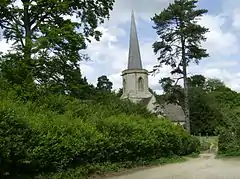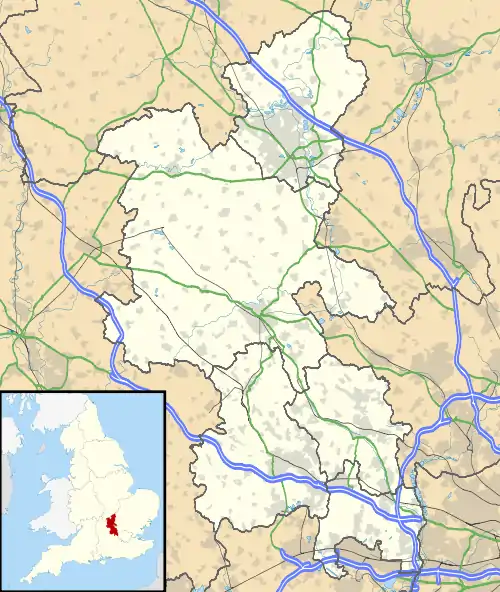Penn, Buckinghamshire
Penn is an English village and civil parish in the Unitary Authority of Buckinghamshire, about 3 miles (4.8 km) north-west of Beaconsfield and 4 miles (6.4 km) east of High Wycombe. Its 3,991 acres (1615 ha) cover Penn village and the hamlets of Beacon Hill, Penn Street, Knotty Green and Forty Green, plus Winchmore Hill.[2] The population was estimated at 4,168 in 2019.[3]
| Penn | |
|---|---|
 Holy Trinity parish church, Penn Street | |
 Penn Location within Buckinghamshire | |
| Population | 3,961 (2011 Census including Tylers Green)[1] |
| OS grid reference | SU912935 |
| Unitary authority | |
| Ceremonial county | |
| Region | |
| Country | England |
| Sovereign state | United Kingdom |
| Post town | High Wycombe |
| Postcode district | HP10 |
| Dialling code | 01494 |
| Police | Thames Valley |
| Fire | Buckinghamshire |
| Ambulance | South Central |
| UK Parliament | |
History
The name is Brythonic in origin and comparable with the modern Welsh typonym pen, which may be translated as hill top or end. The village stands on a well-defined promontory of the Chiltern Hills. From the tower of Holy Trinity Parish Church, it is supposed to be possible to see into eight other counties. The parish also contains a beacon hill with a signal post on it.
The Penn Family
Segraves Manor, the principal seat in Penn, belonged to the Penn family. Sybil Penn, wife of David, was dry nurse and foster mother to King Edward VI and Lady of the Bed Chamber to his sister, Queen Elizabeth I.
The Penn family of Penn were unrelated to William Penn (after whose father, Admiral Sir William Penn, Pennsylvania is named), whose family came from Wiltshire. In 1735 the manor of Penn, passed from the unmarried Roger Penn to his sole heir and sister, who was married to the 3rd Baronet Scarsdale, an ancestor of the Lords Curzon.
Penbury Grove
Penbury Grove House was built in 1902 by the American engineer Horace Field Parshall, as a replica of Pennsbury Manor, William Penn's house in Pennsylvania, wrongly thinking that Penn had a connection with Pennsylvania.
Myths and legends
Penn is reputedly haunted by the ghost of an 18th-century farm labourer, who appears, laughing, on a phantom horse.[4]
Penn Street, Knotty Green and Forty Green
Penn Street, Knotty Green and Forty Green are hamlets of the parish, each within a mile of the main village.
Penn Street and Knotty Green have village commons, where the Penn Street and Knotty Green cricket clubs play.[5] The local pubs, The Squirrel in Penn Street and The Red Lion in Knotty Green, face their respective commons. Forty Green also has a pub – The Royal Standard of England.
Penn today
The area is part of the Chiltern Hills and popular with people who work in London due to its proximity to road (junction 3 of the M40 motorway at Loudwater) and rail (Mainline rail at Beaconsfield and London Underground at Amersham) links into the city.
Penn remains home to Earl Howe of the Penn-Curzon-Howe dynasty, which gained more wealth through the Inclosure Acts, which gave legal property rights to land previously in communal use. In 1855, ownership of Common Wood and Penn Wood passed to the 1st Earl Howe, forcing many local people and their livestock off the land. This caused general unrest within the community.
For centuries, villagers had sustained themselves by grazing their animals on the common and gathering what they could from the land. When the woods became private property, many were plunged further into poverty. Years of unlawful protest followed, when poaching was rife and fences were pulled down as local people tried to retrieve what they deemed legitimately theirs.[6]
Penn Street churchyard contains items from Gopsall, Lord Howe's other country house in Leicestershire. The lychgate and Countess Howe memorial were moved from Congerstone in 1919, when the family sold the Gopsall Estate.
The Cottage Bookshop in Penn was one of the locations for A Tale of Two Hamlets, an episode of the ITV television programme, Midsomer Murders. In addition, it was used to film an episode called "Bookshop Chuckles" in the children's television show ChuckleVision. The three-acre set for Nanny McPhee was also constructed there.
Penn has a non-League football club, Penn & Tylers Green F.C., which plays at Elm Road.
Notable people
The novelist Elizabeth Taylor died in Penn in 1975. Medical pioneers Dr Louisa Garrett Anderson and Dr Flora Murray and the children's writer Alison Uttley, author of the Little Grey Rabbit stories, are buried in the churchyard of Holy Trinity. In 1983, the ashes of the British spy Donald Maclean were scattered in the churchyard. Canadian author Margaret Laurence (1926–1987) lived on Beacon Hill, Penn, between 1963 and 1973, in a house previously owned by the politician Sir Donald Maclean and Lady Maclean, parents of the British spy.
The actor and singer Stanley Holloway lived in Penn with his wife and son for many years in the 1950s and 1960s.[7] Chef and television personality Mary Berry also lives in Penn.
Gabby Logan the TV presenter and her husband Kenny Logan, a former Scotland rugby union international, live in the village. The countertenor Michael Chance was born in the village. The renowned Scots preacher Alexander Whyte spent his last months in the village and preached his last sermon at the Free Methodist Chapel on Church Road. Thomas Horder, 1st Baron Horder, physician to the Royal Family (as was Bertrand Dawson, 1st Viscount Dawson of Penn, who chose the village for the territorial designation of his peerage) lived in the village for several years.
David Blakely, murdered by Ruth Ellis, lived with his parents in the village and brought Ellis there, although never to meet them. As a result of his murder, Ellis became the last woman judicially executed in Britain.[8]
References
- Neighbourhood Statistics 2011 Census Archived 21 October 2016 at the Wayback Machine, accessed 2 February 2013.
- City Population. Retrieved 12 December 2020.
- Ash, Russell (1973). Folklore, Myths and Legends of Britain. Reader's Digest Association Ltd. p. 274. ISBN 9780340165973.
- Penn Street Cricket Club;
- Holloway, Stanley; Richards, Dick (1967). Wiv a little bit o' luck: The life story of Stanley Holloway. London: Frewin. ASIN B0000CNLM5. OCLC 3647363. p. 322.
- Soodin, Vince (12 December 2003). "Is this the time to put this sorry story to rest?". Bucks Free Press. Retrieved 17 February 2020.
External links
| Wikimedia Commons has media related to Penn, Buckinghamshire. |
- Penn and Tyler's Green Community and Village website – run by the Penn & Tylers Green Residents' Society – this site contains news, events, photos and a village map and articles.
- Penn and Tylers Green FC
- Penn Street Cricket Club
- Knotty Green Cricket Club
